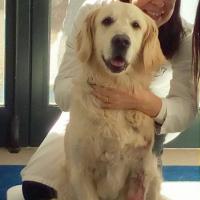‘Not limiting yourself to looking to the future always from the same angle but trying to think about new horizons and opportunities to explore, while always applying critical skills and integrating evidence provided by scientific literature.’ The personal and professional approach of Giordana Zanna (Veterinarian, PhD, graduated from the European College of Veterinary Dermatology (ECVD), and Head of the Veterinary Dermatology Service at the Veterinary Institute of Novara part of the AniCura group) could all be condensed in these few lines.
The courage to challenge yourself and dare, with the support of solid scientific knowledge and evidence, is the springboard to plan a future that turns ‘putting oneself to the test’ into an opportunity, and ‘experimenting’ into an opening to cross the currently known boundaries. All with the awareness that ‘future work can only improve if we continue to want to be positively affected by the scientific influences and innovations they bring.’
It is by following these principles that Dr Zanna approached MLS® Laser Therapy, seeing it as a ‘new therapeutic frontier’: an encounter that opened new paths. ‘The meeting with laser therapy and ASA,’ explained Dr Zanna, ‘was not by chance: I was contacted by the company for a meeting which was followed by the decision to start analysing the potential effectiveness and instrumental efficiency of the therapeutic laser directly. This is when the challenge and desire to put myself to the test began, involving colleagues from other specialized branches, including orthopaedists and anaesthetists. After having collected the most recent scientific evidence, we began to examine the usefulness of therapeutic laser in clinical practice.’ A first step that resulted in further projects in collaboration with ASAcampus.
How did the meeting with ASAcampus take place and what are the doors that opened because of it?
With ASAcampus the meeting was ‘virtual’, considering the restrictions and distances imposed by the COVID-19 emergency. We met online with colleagues who are experts in the sector and we created a research project that earned us the ANICURA 2020 grant. Our goal, with this study, is to evaluate the impact that laser therapy can have on the skin microbiome and on some inflammatory markers in atopic subjects.
In your daily experience, however, you have already had the opportunity to verify the effectiveness of laser therapy: do you remember a particularly significant case in which MLS® best expressed its value?
I think the case of Oliver is strongly representative not only of the value of MLS® Laser Therapy, but also of how ‘not taking the risk would have been more harmful than taking it’. The patient, after a dramatic traumatic event, had to be subjected to the amputation of a limb, but I felt that, before proceeding with this extreme solution, he should have received another chance. I thus assertively communicated to my initially sceptical surgeons that we should try to work jointly, between curettage and laser therapy, with the aim of saving the limb. We did it and it was a success. Oliver today runs on his 4 legs and I will never have enough words to describe how happy I am to have believed in it.
A perseverance that is also the result of a passion written in the DNA and then expressed in a professional journey that led you to specialize in dermatology.
Since I was a child, I have always shown a passion for nature and animals in general; I got it from my father and from what I now call his teachings of civility. The approach to dermatology was instead the result of a thematic post-graduate course and the luck of an enlightening meeting, which made me truly understand what the most correct steps to follow should be in order to achieve a clear goal.
Which ones were key for your growth?
Certainly, the work experiences in England and the Residency in Dermatology course at the Autonomous University of Barcelona of which I am particularly proud. It was extremely constructive and I had the opportunity and privilege of working with leading international colleagues whose teachings I still cherish today.
You currently hold the role of Scientific Head of Veterinary Dermatology at the Veterinary Institute of Novara part of the AniCura group: what is your approach with it and what is your vision on the subject of animal care?
I consider myself lucky to be able to work with a team of colleagues like that of the Novara Veterinary Institute which, being experienced, motivated, and united by a commendable scientific background, is the strong point of my daily working life. Given that we have a multidisciplinary approach aimed at the most attentive care for our patients, my vision is to combine scientific preparation and/or personal skills with effective and humane communication. A method that I consider respectful of the client but above all useful for improving the care for our patients.
An approach that shows how the role of the veterinarian has changed over time, as well as the opportunities for professional growth...
Compared to the past, I believe that today’s veterinarians have the opportunity to expand their knowledge without limiting themselves to what they learned during the degree course. The training opportunities, today centred on planning and perfectly aligned to modern needs, are a must. Future work can only improve if we continue to want to be positively affected by the scientific influences and innovations they bring.

